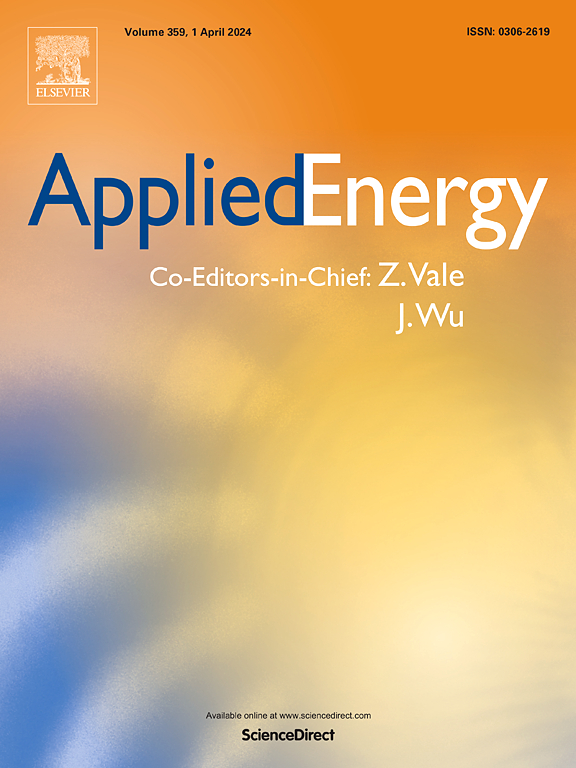Closed-loop synergistic strategy for low-carbon calcium carbide production: Integrating biochar-gas co-supply, multi-stage waste heat valorization, and solid waste calcium-looping
IF 11
1区 工程技术
Q1 ENERGY & FUELS
引用次数: 0
Abstract
The typical energy-intensive calcium carbide industry generates substantial amounts of high-grade waste energy and solid waste resources. Its potential in future green and low-carbon industrial scenarios deserves in-depth exploration. In this regard, this study proposes a low-carbon synergistic calcium carbide system to form a novel closed-loop strategy combining biomass charcoal-gas cogeneration, steam Rankine cycle thermoelectric conversion, solid waste recycling and multi-stage heat utilization of residual energy. The thermodynamic, environmental and economic performance of this innovative system is assessed, with particular attention to critical parameter impacts. Findings reveal that the cogeneration of biochar and gas, alongside calcium recycling of solid waste carbide slag, has substantially unlocked new low-carbon sources of carbon and calcium for the calcium carbide industry. The CO2 emission of the proposed system is 0.234 t/GJ, notably superior to the coal industry's 0.328 t/GJ. Steam Rankine cycle thermoelectric conversion and multi-stage heat utilization effectively recover approximately 3000 kW of system waste energy, with the working range of steam Rankine cycle module featuring turbine steam heat regeneration being expanded, resulting in a further 6.5 % enhancement in steam Rankine cycle efficiency, enabling the calcium carbide system to co-generate around 1300 kW of electrical energy. Economic analysis identifies the critical market price 1.83 USD/kg as the key criterion for evaluating the system's profitability feasibility. Furthermore, the analysis of critical parameters indicates that the optimal reaction temperature for calcium carbide production and biomass gasification pressure are 1700 °C and 45 bar, respectively, which significantly enhance products output, thermodynamic efficiency and emissions reduction. The proposed system holds significant practical value for addressing the challenges of high energy consumption and high emissions in traditional industries and propelling the green and low-carbon transformation of the chemical industry.

低碳电石生产的闭环协同策略:整合生物炭-气共供、多阶段废热增值和固体废钙循环
典型的能源密集型电石工业产生大量的高品位废能源和固体废物资源。它在未来绿色低碳工业场景中的潜力值得深入探索。为此,本研究提出低碳协同电石系统,形成生物质炭-气热电联产、蒸汽朗肯循环热电转化、固废回收和余能多级热利用相结合的新型闭环策略。评估了这一创新系统的热力学、环境和经济性能,特别注意了关键参数的影响。研究结果表明,生物炭和气体的热电联产,以及固体废电石渣的钙回收,为电石行业开辟了新的低碳碳和钙来源。系统的CO2排放量为0.234 t/GJ,明显优于煤炭行业的0.328 t/GJ。蒸汽朗肯循环热电转换和多级热利用有效回收了约3000千瓦的系统废能,扩大了汽轮机蒸汽热再生的蒸汽朗肯循环模块的工作范围,使蒸汽朗肯循环效率进一步提高6.5%,使电石系统共产电能约1300千瓦。经济分析将关键市场价格1.83美元/公斤确定为评估系统盈利可行性的关键标准。关键参数分析表明,电石生产的最佳反应温度为1700℃,生物质气化压力为45 bar,可显著提高产品产量、热力学效率和减排效果。该系统对于解决传统工业高能耗、高排放的挑战,推动化工行业绿色低碳转型具有重要的实用价值。
本文章由计算机程序翻译,如有差异,请以英文原文为准。
求助全文
约1分钟内获得全文
求助全文
来源期刊

Applied Energy
工程技术-工程:化工
CiteScore
21.20
自引率
10.70%
发文量
1830
审稿时长
41 days
期刊介绍:
Applied Energy serves as a platform for sharing innovations, research, development, and demonstrations in energy conversion, conservation, and sustainable energy systems. The journal covers topics such as optimal energy resource use, environmental pollutant mitigation, and energy process analysis. It welcomes original papers, review articles, technical notes, and letters to the editor. Authors are encouraged to submit manuscripts that bridge the gap between research, development, and implementation. The journal addresses a wide spectrum of topics, including fossil and renewable energy technologies, energy economics, and environmental impacts. Applied Energy also explores modeling and forecasting, conservation strategies, and the social and economic implications of energy policies, including climate change mitigation. It is complemented by the open-access journal Advances in Applied Energy.
 求助内容:
求助内容: 应助结果提醒方式:
应助结果提醒方式:


